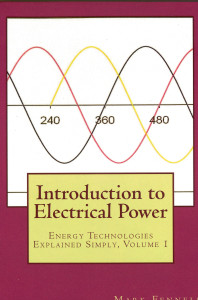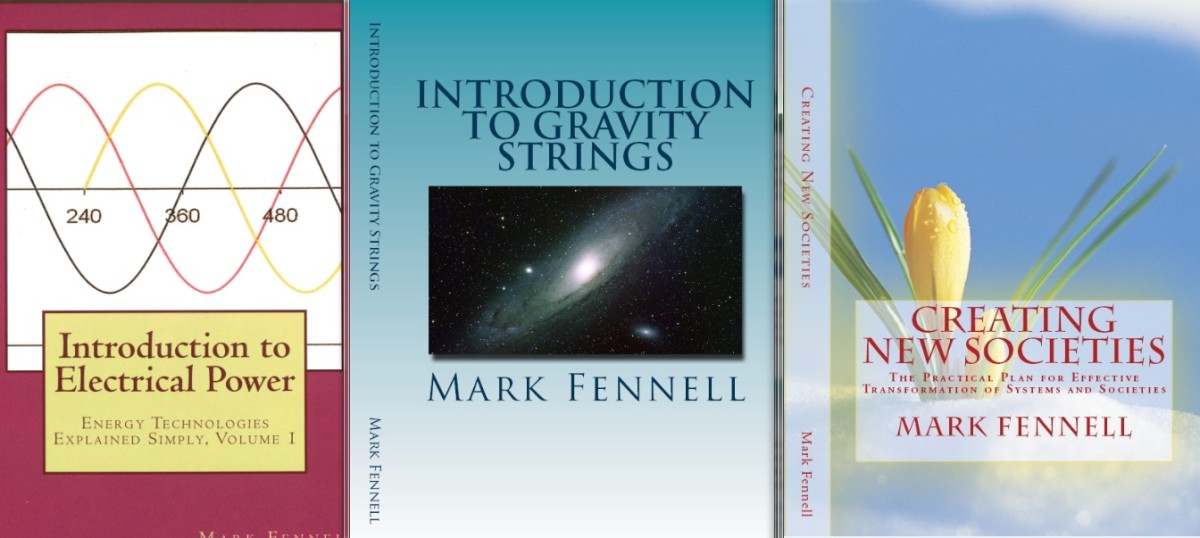Introduction to Electrical Power (paperback)
 Introduction to Electrical Power is the first volume in the series of Electrical Power Explained Simply. This book explains the essential concepts behind electrical power, including power generation, electrical current, and basic circuitry.
Introduction to Electrical Power is the first volume in the series of Electrical Power Explained Simply. This book explains the essential concepts behind electrical power, including power generation, electrical current, and basic circuitry.
Readers will also learn of new discoveries in the fundamental nature of electrical power. These are significant discoveries which the author has made from his extensive research and analysis. These discoveries will not be found anywhere else! Topics include: Energy, Power, Voltage, Current, Turbines, Generators, Batteries and Electrical Connections. These topics are fundamental concepts which apply to all books in the Series.
This book is designed for readers with little or no technical knowledge. Every concept is explained using simple language, a conversational style, detailed diagrams, and guided examples. This book is perfect for policy makers, students, and the general public.
Chapters include:
- Basic Principles of Electrical Power
- Operation of Turbines and Generators
- Voltage, Current, and Power on the Atomic Scale
- Alternating Power and Frequency
- Voltage & Current Sine Wave Graph
- Batteries
- Resistance and Temperature
- Electrical Connections
- Primary Electrical Terms
- Impedance and Reactance
- Appendix Material: Conversions, Units, Terminology
- Index
Additional Items Found ONLY in this Book !!
There are several items which are found ONLY in this book. No other book on electricity will have these concepts.
A. Voltage explained more simply and accurately: I have a much simpler, and more accurate explanation of voltage. In brief: voltage is the overall energy of electrons at a particular location. This is easier to understand than the “potential” which is often used.
B. Current explained more accurately: I have a deeper understanding of electricity, as well as all types of energy transfer. Therefore in this book I present for the first time the true process of electrical current. In brief: electrons do not flow very far; rather they bump into each other. This bumping causes the electrical energy strings to transfer from one electron to the next. That simple process is the basic process of electrical current. This is a discovery I made, and can explain numerous other observations. (This process is explained in greater detail in this book).
C. Batteries explained simply; with new insights: There will be a full book on Battery Technologies. However, I knew that it would be a while before I completed that book. Therefore this chapter has detailed descriptions, with illustrations, of the battery process. These illustrations are based on those I used when teaching these concepts to chemistry students years ago. Furthermore, I provide some insights on the anode and cathode processes…insights which later proved to be more true than even I realized, and have been substantiated with later discoveries presented in other books. All of this is unique to the book Introduction to Electrical Power.
D. Sine Wave Graphs: The sine wave graphs are very important. They provide useful information about the current, voltage, and power. Yet most books just throw the graphs up there, without showing you how to read them. In this book, you will be shown the physical process which corresponds to each point along each sine wave graph. I spend time with this so that you can have a physical, intuitive, understanding of these important graphs.
E. Appendix Material and Index: I provide appendix material and index for each of the books. In this book you will find useful information on energy units, energy unit conversions, and wire sizing.
This book is a precursor to all other books. Every other book in the series uses the information in this book, and builds upon it.
Many illustrations are full color.
